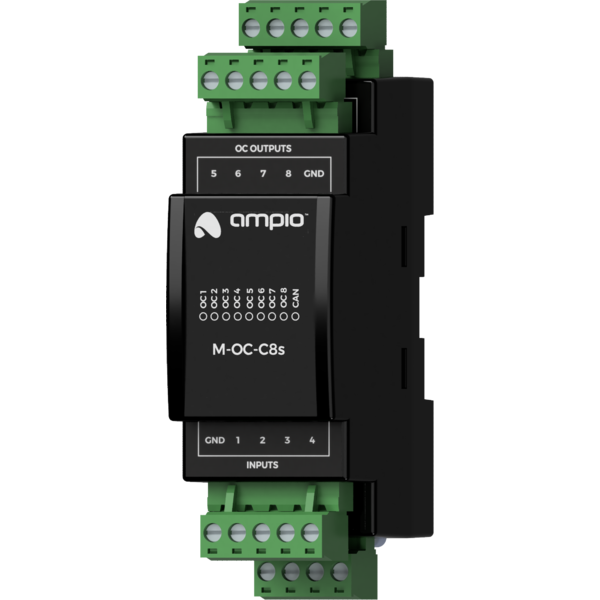
The image above is for illustration purpose only. The actual module may vary from the one presented here.
Module M-OC-C8s is a component of the Ampio system. Required voltage to power the module is 11 — 16V DC. The module is controlled via CAN bus.
The module has eight OC outputs, four ground-detecting inputs and supports the functionality of an RGBW lighting controller.
The module has open-collector outputs allowing for smooth control of resistive loads supplied with voltage of up to 40V DC. It is also allowed to control loads of moderate inductive nature, in particular relays. Control is performed by the method of pulse-width modulation (PWM). Internally, each of the outputs allows the connected line to be short-circuited to the module’s ground.
As part of the module’s configuration, it is possible to activate the functionality of the RGBW lighting controller. Nominally, each of the open-collector outputs is controlled independently. When the functionality is activated, the control is done by defining the colour and intensity of the light.
The module allows to control one RGBW light source - outputs not configured to work in the discussed mode will function as normal general-purpose OC outputs.
The module has inputs that go into the active state when they are shorted to ground. They can be used in the case of any devices with potential-free contact outputs, e.g. wall switches, reed switches, buttons, switches, etc. They can also be used for integration with devices with potential-free relay outputs or optocoupler outputs with a collector voltage greater than 12V.
The module is designed for mounting on a 35mm DIN rail. The module’s width is 35mm, 2 spaces/modules in DB. In order to start the module, it must be connected to the CAN bus. The bus of the Ampio system consists of four wires - two for power and two for communication between the modules.
In addition to the CAN bus connector, the device has a connector that allows for the fastening of eight signal lines to ground detecting inputs and eight resistive loads to open-collector outputs.
When using the open-collector outputs functionality, it should be borne in mind that the supply circuits of the connected loads are closed by the mass of the module. Therefore, it should be ensured that the mass of the device is connected to the mass of the power supply with a cable of appropriate thickness.
The ground line must be attached to both open-collector output connectors. The omission of the connection is allowed if the outputs of a given connector are not used.
On the front of the module there are signalling LED indicators. The green LED with the label CAN indicates the status of communication on the CAN bus:
Apart from the diode that indicates the status of the communication bus, on the front of the device there are also four red diodes indicating the status of the open-collector outputs.
The module is programmed with the use of the Ampio Designer software. It allows you to modify the parameters of the module and define its behaviour in response to signals directly available to the module as well as general information coming from all devices present in the home automation bus.
Dimensions expressed in millimeters. The module’s connectors are located in two rows. Their position does not interfere with the cover of the electrical distribution board. However, they should be taken into account in the case of non-standard installation of the device.
Click to enlarge and open in a new tab.
The presented power supply of OC outputs controlled devices is for reference only. The module can control loads with a supply voltage up to 40V DC.